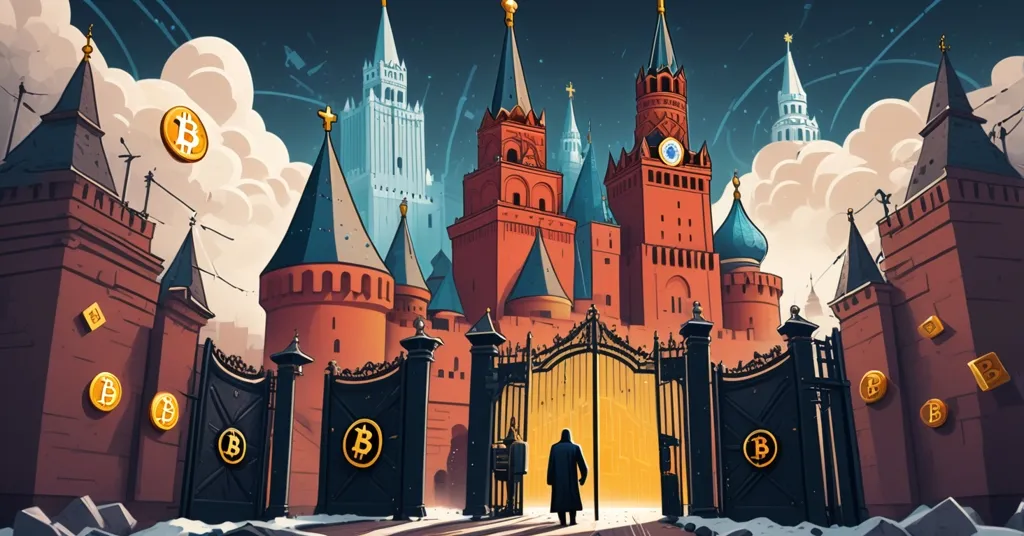Russia’s 2025 Crypto Crackdown: State Control vs. Blockchain Freedom

Crypto Regulations in Russia 2025: Iron Grip or Blockchain Blueprint?
Russia’s 2025 cryptocurrency regulations mark a pivotal moment for the nation’s blockchain ambitions, blending aggressive state control with undeniable market growth. As the Kremlin rolls out stringent laws to shape a secure digital asset ecosystem, the tension between innovation and oversight raises critical questions about the future of decentralization in one of Europe’s crypto powerhouses.
- Heavy-Handed Rules: Mining registries, Tether bans, and elite-only trading access define Russia’s 2025 crypto crackdown.
- Adoption Surge: User penetration hits 29.06%, with market revenue projected at $2.3 billion despite restrictions.
- State vs. Freedom: Can a tightly controlled crypto landscape align with blockchain’s rebellious roots?
Russia’s Crypto Journey: From Bold Start to Tight Leash
Since legalizing digital financial assets (DFAs) in July 2020 under President Vladimir Putin, Russia has positioned itself as a significant player in the European blockchain arena. That initial move was a calculated step to embrace decentralized technologies amid mounting Western sanctions and geopolitical friction, particularly after the 2014 Crimea annexation and escalating tensions since 2022. Crypto offered a lifeline—a way to bypass traditional financial systems like SWIFT and reduce reliance on the US dollar. By 2025, however, the narrative has shifted from open experimentation to ironclad control. Led by the Bank of Russia, the government is crafting a state-dominated crypto ecosystem, aiming to harness economic potential while stamping out risks like fraud, tax evasion, and energy misuse. This evolution reflects not just domestic priorities but a broader geopolitical strategy for financial sovereignty, with digital assets and projects like the digital ruble playing starring roles.
Mining Under the Microscope: No Free Power Plays
Cryptocurrency mining, the engine behind networks like Bitcoin and Ethereum, faces a brutal reckoning in Russia this year. On July 7, 2025, the Ministry of Energy launched a national registry for mining equipment, a system designed to track hardware and combat electricity theft—a rampant issue given Russia’s historically cheap power rates. Miners are now classified as “fourth category” consumers, meaning their energy needs rank below essential services. President Putin himself underscored the strain, stating in a recent address that miners have “used up surpluses in some regions,” prompting decisive action. The message is clear: no more freeloading on the grid, as highlighted by recent Bitcoin mining laws and their energy impact.
For those who skirt the rules, the consequences are savage. As of June 9, 2025, fines for illegal mining—operations not registered with the state or violating energy and tax laws—have soared to 2 million rubles (about $25,500), up from a mere 200,000 rubles previously. That’s not a slap on the wrist; it’s a financial knockout for small-time miners dreaming of easy profits. Worse still, mining is outright banned in energy-scarce regions like the North Caucasus and occupied Ukrainian territories, with mining restrictions drawing significant online discussion. However, a small reprieve exists: miners using less than 6,000 kWh per month are exempt from registration, offering a sliver of hope for hobbyists. While the state’s concern over energy deficits is valid, one must question whether such a stranglehold risks choking out grassroots innovation. After all, mining is the heartbeat of Bitcoin’s decentralized ethos—can it survive under this level of scrutiny?
Stablecoin Showdown: Tether in the Crosshairs
On May 26, 2025, the Bank of Russia fired a warning shot at stablecoins, floating a potential ban on Tether (USDT) and others tied to “hostile issuers.” For the uninitiated, stablecoins are digital currencies pegged to stable assets like the US dollar to avoid the wild price swings of Bitcoin or Ethereum. They’re often used for trading or sending money across borders with minimal volatility. The central bank’s beef? These tokens, controlled by foreign entities, can be frozen or blocked, a real threat for Russian users already navigating a web of international sanctions. While some exceptions may allow stablecoins for cross-border settlements, domestic trading within Russia’s financial “sandbox”—a controlled testing environment for digital assets—could be off the table, with further analysis on the Tether ban reasons shedding light on the implications.
This is a sharp jab at market liquidity, potentially crippling traders who rely on USDT for quick, stable transactions. As an alternative, the state is pushing options like RUBX, a ruble-pegged stablecoin designed to dodge US regulatory oversight and bolster financial independence. On one hand, a state-backed stablecoin could offer predictability in a sanction-heavy climate. On the other, it’s a far cry from crypto’s borderless vision. Bitcoin, at least, answers to no central issuer, hostile or otherwise—a trait Russian regulators might secretly respect even as they tighten the screws. Beware, though—if bans push users underground, unregulated platforms often become breeding grounds for scams. We’ve seen too many rug pulls to ignore the danger, and the impact of a Tether ban is already a hot topic of debate.
Elite Access Only: Trading Barriers for the Masses
If you’re an average Russian hoping to dip into crypto, tough luck. As of March 12, 2025, the Bank of Russia has restricted trading to “super qualified” investors—those with assets of at least 50 million rubles in 2024, escalating to 100 million rubles (roughly $500,000 to $1 million) this year. Think of it as a VIP pass to a concert: only the ultra-rich get in, while most are stuck outside. The central bank claims this shields retail investors from crypto’s notorious volatility and scams, a not-unreasonable concern given the sector’s history of wipeouts. They’ve even greenlit financial institutions to offer crypto-linked derivatives and securities to these elite players, as noted in their May 28 statement:
“Financial institutions may offer qualified investors financial derivatives, securities, and digital financial assets whose yields are linked to cryptocurrency prices.”
Yet, this reeks of elitism. A technology born to democratize finance is now a walled garden for the wealthy. To play devil’s advocate, protecting the little guy from losing everything makes some sense—but shouldn’t education, not exclusion, be the tool? This move clashes hard with decentralization’s promise, turning crypto into a privilege rather than a right, especially under the framework of Russia’s 2025 crypto regulations.
State Oversight and Global Scrutiny: No Room for Slip-Ups
Russia’s control extends beyond trading to every corner of the crypto space. A draft bill from May 19, 2025, classifies cryptocurrency as property, meaning your Bitcoin stash can be seized in criminal proceedings just like physical assets. Crypto platforms must now register with the Bank of Russia, secure a Virtual Asset Service Provider (VASP) license—a mandatory permit to operate legally—and comply with strict anti-money laundering (AML) and counter-terrorism financing (CTF) laws. Dodging these rules isn’t a minor offense; new tax laws effective January 1, 2025, carry prison sentences for non-compliance. The message is blunt: play by our rules or pay the price, as detailed in the broader context of cryptocurrency legality across territories.
Globally, Russia’s crypto credibility took a hit with EU sanctions on Garantex, a major Russian exchange, in March 2025. Following an International Court of Justice investigation linking Garantex to government entities and criminal networks—including ties to Rosneft and Moscow gang leaders—its operations were halted. This isn’t just a local setback; it undermines Russia’s narrative of cleaning up illicit activity while such players operate under its nose. Sure, cracking down on dirty money is crucial, but at what cost to privacy and trust? When state oversight borders on surveillance, one wonders if the cure is worse than the disease for a technology built on anonymity, with more details emerging from the Garantex sanctions investigation.
Adoption Surge: Russians Hungry for Digital Assets
Despite the regulatory vice grip, crypto adoption in Russia is booming. User penetration stands at 29.06% in 2025, with forecasts to reach 30.88% by 2026, equating to over 44 million users. Market revenue is projected at $2.3 billion this year, with a staggering annual growth rate of 68.45%, potentially hitting $3.9 billion by 2026. The average revenue per user sits at $55.2—not massive, but a sign of widespread interest. Why the hunger? Economic uncertainty, inflation fears, and distrust in traditional banks likely drive many Russians to digital assets as a hedge, even with barriers in place.
Institutional players are fueling the fire too. Sberbank, Russia’s largest bank, has jumped into crypto custody services, tokenized assets, and Bitcoin-linked bonds, blending traditional finance with blockchain under the state’s watchful eye. This fusion shows promise—a controlled bridge to mainstream adoption. Yet, with access limited to the elite, the question looms: who’s really benefiting? The numbers scream demand, but true decentralization feels miles away when only a select few can play, especially with policies like the mining equipment registry adding further complexity.
What’s Next for Russia’s Crypto Experiment?
Russia’s 2025 regulations reveal a nation wrestling with a paradox: embracing the future of money while chaining it to state interests. On the optimistic side, this heavy-handed approach could position Russia as a leader in state-backed blockchain innovation. Tools like RUBX and the digital ruble might offer stability in a world of sanctions, carving out a niche for controlled crypto economies. Market growth, with billions in revenue and millions of users, signals a robust foundation for long-term impact. If navigated smartly, Russia could inspire other nations to blend traditional finance with decentralized tech—effective accelerationism in action.
But the dark side looms large. Trading restrictions alienate the masses, mining crackdowns burden small players, and stablecoin bans risk pushing users into black-market cesspools rife with fraud. Bitcoin’s decentralized nature—its refusal to bend to any authority—could make it the last refuge for Russians seeking financial freedom outside the Kremlin’s sandbox. Yet, state dominance threatens to morph crypto into just another cog in the centralized machine, far from its disruptive roots. Could this model stifle the very innovation it seeks to harness? And globally, with Garantex’s sanctions casting shadows, will Russia’s blockchain ambitions earn trust or suspicion? One has to ponder if a state-controlled crypto ecosystem can ever embody blockchain’s defiant spirit.
Key Takeaways and Questions on Russia’s Crypto Landscape
- What drives Russia’s 2025 crypto regulations?
The core aim is to balance innovation with security, curbing fraud, tax evasion, and energy misuse while integrating digital assets into a state-controlled financial system for stability and geopolitical leverage. - How do these rules limit crypto access for most Russians?
Trading is restricted to wealthy “qualified” investors with assets of 50-100 million rubles, excluding the average citizen and sparking debate over fairness in a tech meant to democratize finance. - What are the risks of banning stablecoins like Tether?
A USDT ban could slash liquidity and hinder cross-border trades, potentially driving users to risky unregulated platforms or state alternatives like RUBX, with uncertain impacts on market freedom. - Why is crypto adoption skyrocketing despite restrictions?
With 29.06% user penetration and $2.3 billion in revenue, Russians see crypto as a hedge against economic woes and banking distrust, showing resilience even under tight controls. - What challenges do miners face under new laws?
Mandatory equipment registries, fines up to 2 million rubles, regional bans, and new taxes pile on costs and legal risks, hitting small miners hardest while aiming to manage energy deficits. - How does Russia’s approach compare to global crypto policies?
Unlike the EU’s harmonized MiCA framework, Russia prioritizes state dominance over market freedom, a stark contrast to Bitcoin’s borderless ethos and a test of centralized control’s limits. - Can Bitcoin thrive under such state oversight?
Bitcoin’s decentralized core resists central authority, potentially making it a haven for financial freedom in Russia, though heavy regulations could dull its disruptive edge if adoption stays elite-focused.
Russia’s crypto gamble in 2025 is a high-wire act. The Kremlin is betting that rigid oversight will forge a stable, state-friendly blockchain economy, even if it means sidelining the grassroots rebellion that birthed Bitcoin. Whether this stifles the global crypto revolution or carves a controversial new path remains unanswered. One thing is non-negotiable: there’s no tolerance for scammers or baseless hype in this space. We’re here to cut through the noise, champion decentralization, and push for a future where freedom, not control, defines the game.



